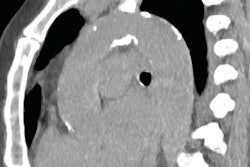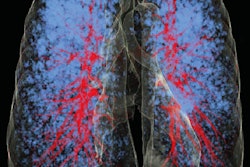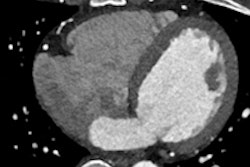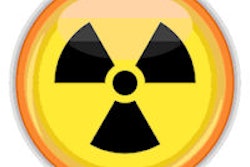
In one of the first studies to combine a high-pitch cardiac CT angiography (CCTA) imaging protocol with iterative reconstruction, researchers from Beijing have reduced radiation doses to less than 1 mSv, with good image quality even in heavier patients, according to a new paper in European Radiology.
The authors succeeded in performing ultralow-dose CT angiography in all 40 patients scanned, yielding diagnostic image quality in more than 90% of the patients. Per-patient sensitivity was also high -- nearly 96% with specificity of 94% for significant coronary stenosis. Even per-vessel sensitivity flirted with the 90th percentile, while the mean effective dose was just more than 0.5 mSv per patient.
"High-pitch spiral CCTA provides relatively high diagnostic accuracy for CAD [computer-aided diagnosis] detection in a consecutive population only selected by heart rate and also including overweight individuals," noted Wei-Hua Yin from the Chinese Academy of Medical Sciences and Peking Union Medical College and the Medical University of South Carolina in Charleston, U.S., along with colleagues from the same institutions.
"Furthermore, the combined application of high-pitch image acquisition along with iterative reconstruction allowed for substantial radiation dose reductions" (Eur Radiol, November 2013, Vol. 23:11, pp. 2927-2933).
Conventional CCTA yields impressive results in ruling out coronary artery disease, but radiation dose remains a concern and ultralow-dose studies are lacking. Prospective ECG-triggering of the CT images, and reduced tube current settings have yielded significant dose reductions in previous papers, but diagnostic image quality has been limited to nonobese patients in studies of patients scanned at 100 kV, the authors wrote.
Iterative reconstruction is another good tool for overcoming image quality limitations, mainly by overcoming the limitations of the back projection process in image reconstruction. But to date, iterative reconstruction techniques have not been combined with kV reductions and high-pitch spiral acquisitions in CCTA, they said.
"Therefore, the aim of our investigation was to explore the feasibility and diagnostic accuracy of such an approach in a consecutive patient population selected only by heart rate, with the goal of keeping radiation exposure from this test consistently under 1 mSv," Yin and colleagues wrote.
Dual-source CT
The study examined 40 consecutive patients (mean age 52.9 ± 8.7, 70% male) with stable heart rates of 60 beats per minute (bpm) or less (mean heart rate 54 ± 4, range 43-61) using two exams: ultralow-dose CCTA and conventional angiography scans, acquired within a week of each other.
Iodinated contrast but no beta-blockers or nitroglycerine was administered before exams on a second-generation dual-source CT system (Somatom Definition Flash, Siemens Healthcare).
The protocol included 2 x 64 x 0.6-mm collimation, 0.28-second gantry rotation time and 3.4 pitch, and attenuation-based tube current modulation (CareDose 4D, Siemens). Bolus tracking and a triphasic contrast medium injection included 50 mL to 60 mL of undiluted contrast (370 mgL/mL iopromide, Ultravist, Bayer Healthcare) followed by a 70% contrast/saline mixture and a 40-mL saline flush.
The x-ray tube current was cut to half the standard dose; 160 mAs and 120 kV was used for patients with a body mass index (BMI) greater than 25 kg/m²; 100 kV and 186 mAs for patients with BMI of 20 to 25; and 80 kV with 200 mAs for patients with BMI less than 20. The mean BMI for all patients was 25.5 ± 3.1 with a range of 19.8 to 31.1.
Images were reconstructed using sonogram-affirmed iterative reconstruction (SAFIRE, Siemens Healthcare) with thickness of 0.75 mm and a 0.5-mm increment and a 146f kernel. Noise suppression was set at a medium level, and radiation doses were based on the CT volume dose index (CTDIvol) and dose-length product (DLP) read from the patient protocol summary.
Three radiologists blinded to clinical data and conventional coronary angiography results evaluated image quality in consensus using an offline workstation (Advantage Windows, GE Healthcare), according to the study team.
Half had significant disease
In all, 23 of 40 patients (57.5%) had obstructive disease in 57 of 160 coronary vessels. Three patients had left main disease, 10 had three-vessel disease, and 10 had two-vessel disease. CCTA results in 40 patients showed that more than 90% of images were diagnostic, with per-patient sensitivity of 95.7% and specificity of 94.1%.
| CCTA diagnostic accuracy per segment and per patient | ||
| Parameter | Per segment | Per patient |
| Sensitivity | 77.7% | 95.7% |
| Specificity | 95.2% | 94.1% |
| Positive predictive value | 76.9% | 95.7% |
| Negative predictive value | 95.4% | 94.1% |
| False positives | 4.8% | 5.9% |
| False negatives | 22.3% | 4.3% |
As for image quality, on a scale of 1 to 4 with four being optimal, the mean per-segment image quality score was 3.02 ± 0.86. Of 601 total segments analyzed, 90.3% were of diagnostic image quality, including 27.9% that scored 4, 55.4% scoring 3, and 7% scoring 2, according to the authors.
"Comparable to the results of similar previous studies performed in cohorts of nonconsecutive, nonobese individuals, the overall image quality in our investigation was generally considered to be high, at acceptable image noise levels, despite the low radiation dose delivered to the patients," Yin and colleagues wrote. At the same time, the number of nonevaluable segments remained low compared with studies that used high-pitch spiral acquisition and standard filtered back projection reconstruction, they said.
The area under the receiver operating characteristic curve was 0.949 per patient and 0.913 per vessel. The mean effective dose was 0.58 ± 0.17 mSv, with a range of 0.28 to 0.91 mSv. The mean size-specific dose estimate (SSDE) was 3.14 ± 1.15 mGy.
"[H]igh-pitch spiral CCTA provides relatively high diagnostic accuracy for CAD detection in a consecutive population only selected by heart rate and also including overweight individuals," the group wrote. Nearly half of the patients had hypertension and hyperlipidemia, 15% had diabetes mellitus, 28% smoked, and 7.5% met the criteria for obesity.
New ground for iterative plus high pitch
Nevertheless, "the combined application of high-pitch image acquisition along with iterative reconstruction allowed for substantial radiation dose reductions," the group wrote. "All our studies were performed with a radiation dose equivalent to less than 1 mSv, even in patients with higher BMI."
As for limitations, relying on a patient cohort referred for invasive angiography "unavoidably introduces bias," they noted. And although the presence of obstructive disease in 57% of patients was lower than in similar studies, it was still higher than in patients undergoing clinically indicated CCTA, they wrote, adding that the results would be strengthened by larger multicenter studies, and by further improvements in CT technology.
Still, the success of the imaging technique in such a varied cohort is good news for ultralow-dose CT. "Our proposed approach may thus widen the spectrum of patients who can be successfully imaged with exceedingly low radiation exposure," Yin and colleagues wrote.



















